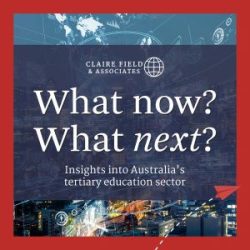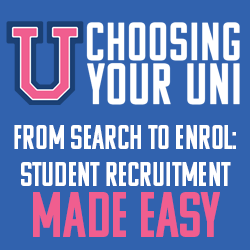Transnational education (TNE) provides an opportunity to contribute to a multi-layered internationalisation strategy for some Australian education and training institutions. However, it is not the solution to a reduction in onshore enrolments nor to diversifying the student population. The draft Australia’s International Education and Skills Strategic Framework asked two questions about TNE in its consultation, with submissions due last Friday, 14 June. Below is what I would have said if there had been no character limit, and my actual response is provided at the end.
A recommendation of the Australian Universities Accord Final Report released in February promotes transnational education (TNE) to support diversification of international student markets. Following on from this, the draft Australia’s International Education and Skills Strategic Framework contends that Australian education and training providers should be capitalising on market opportunities as one way of managing sustainability and future growth.
Submissions to the consultation on the draft Framework were due last Friday, 14 June and asked two questions relating to TNE:
- What are the barriers to growth in offshore and transnational delivery of Australian education and training?
- Where can government direct effort to support transnational education?
In response to these questions, we need to ask, why do we want to grow offshore and transnational delivery?
Despite the effusive praise for TNE in the draft Framework, asserting that “within our region and beyond, there is untapped potential to support both capacity development and local demand for education”, from my experience, untapped potential simply doesn’t exist in any kind of volume, and even fewer opportunities can provide the return on investment that make the effort involved in establishing and delivering TNE worthwhile.
Therefore, if the intention of the government is for education and training providers to replace lost revenue from onshore international students, then TNE is not the solution. However, it does provide an opportunity for Australian education and training providers to enhance their brand reputation and recognition internationally.
Changes in the operating environment
Establishing TNE requires a significant investment of resources and a long-term commitment. These branch campuses have been in operation for decades:
University of Wollongong Dubai – 31 years
Monash Malaysia – 26 years
RMIT Vietnam – 24 years
Swinburne Sarawak – 24 years
JCU Singapore – 21 years
Curtin Singapore – 15 years
The international operating environment that existed when Australian universities established branch campuses overseas is vastly different to the one that exists today. Domestic university capacity and quality was limited in these countries, and this led to foreign governments supporting the establishment of overseas education providers.
There are few, if any, remaining countries with the kinds of opportunities that existed decades ago. In some cases, domestic capacity has improved, in others, the regulatory environment still does not allow foreign providers. There is also a question of demand/capacity to pay.
Brand recognition and reputation
New branch campuses are in the minority of TNE delivery models and recently established campuses are intentionally only offering a small suite of courses in comparison to the established overseas campuses. For example, Monash Indonesia offers eight master’s degree programs and a Doctor of Philosophy, Deakin University’s campus in India currently only offers two postgraduate degrees and although there are plans for expansion they are still limited, and University of Wollongong’s India campus will offer three postgraduate and two bachelor courses by 2025.
With a limited suite of offerings, no new branch campuses will deliver the volumes of students required to equal the profit of enrolling international students onshore. Instead, brand recognition and reputation are likely to be the main motivators for these campuses. Monash, Deakin and Wollongong have received significant recognition from the governments of Indonesia and India as a result of establishing their campuses.
Partnerships
Most TNE is offered with a partner, and in my experience for the number of successfully negotiated TNE arrangements, there are more that have been abandoned. The TEQSA Transnational education toolkit provides excellent insights into the complexity of negotiating and managing these kinds of partnerships. It warns providers not to “underestimate how much work is required to manage a successful partnership”. The resource implications of establishing and ongoing management of these arrangements are also a barrier to entry.
There is also an opportunity cost and prioritisation issue associated with a TNE partnership. In the establishment phase, if academics are involved, then they are juggling their responsibilities to the main campus and their research while investigating the prospect of a new partnership. I have experience from my time with Austrade offshore with Australian providers taking weeks or even months to respond in progressing TNE opportunities.
In the delivery phase, there is a conundrum for providers. Do they send their tenured academics who are embedded in the institution and the course, but then need to be replaced on the main campus? Or do they send a sessional staff member who does not have the same profile or commitment to the institution?
Student demand and the study in Australia experience
This leads to the question of student demand and whether there is a volume of student enrolments that makes TNE worthwhile.
TNE does not provide a full study in Australia experience and if students have the capacity to pay, they will choose to study overseas. Although a TNE course provides the curriculum of the Australian provider, teachers/academics are either locally employed or fly-in, fly-out.
Tuition fees for TNE are also set at a premium, not at local rates. This leaves a small slice of students in each market who have the capacity to pay for a foreign education but not enough to study overseas. This is even more difficult at the vocational education and training level, which is not afforded a level of prestige in most countries and therefore there is lower demand for an Australian qualification.
In the case of online study, there is a limited market of students who want to study with a foreign provider online, have the technology that enables them to do so, and have a capacity to pay but choose not to study in their own country.
Case studies
RMIT Vietnam is an instructive case study. It is arguably the brand leader in foreign-owned universities in Vietnam, following its establishment 23 years ago. Crucially, it has always had the support of the Vietnamese government.
In 2023, RMIT had almost the same number of students enrolled in Vietnam (14559) as international students enrolled in higher education onshore (14661) (2023 Annual Report). The revenue earned from students onshore was $384.5 million, compared to $226.2 million in Vietnam. International students onshore in Melbourne also provided RMIT with economies of scale and cross-subsidised research and domestic student activities. RMIT has also announced that it will be investing $250m in Vietnam as part of a strategic investment fund.
This is not to say that RMIT should not be operating in Vietnam, it made a profit of $67.3m (noting it does not repatriate surpluses). However, it is instructive for new entrants, as this has been years in the making and a profit has not always been the case. There is also an expectation from foreign governments that overseas institutions will make an investment in the country they are delivering in.
Regulatory environment
Finally, the regulatory environment in both Australia and overseas can be a barrier. Australian providers are required to adhere to the regulatory environment in both countries, even though the course is not being taught in Australia. This can be burdensome and complex.
This all begs the question for executive teams in Australia’s education institutions as to why TNE. Finding profitable opportunities that can take years to see a return on investment needs to be balanced with core business and finite resources. The fact remains that the yield of an international student onshore is higher than one offshore.
Where can government direct effort to support transnational education?
As someone who has managed TNE programs for an Australian university, I believe that the 2022 TEQSA Transnational education toolkit is an excellent resource for Australian education providers who are new to TNE. There may be opportunities to bring the Toolkit to life in other ways, to make it easier to use, and provide additional resources to support its use.
There are two areas of in-country due diligence taken from the Toolkit where government could direct effort to support TNE:
- Legislative scanning to understand the scope of all relevant in-country laws (such as privacy and data protection, labour laws, fraud, antibribery), including compliance requirements
- Market analysis is part of the due diligence process and should be performed regularly with an eye to considering emerging markets and competitors
The Australian government has diplomatic representation in many countries in which an Australian education provider may consider offering a TNE program. Enhancing their role in supporting initial TNE exploration would be one way to direct effort.
For example, an education provider may wish to do an initial exploration of an opportunity in a new market. It would be helpful if the Australian government representatives were able to provide current information that addresses the issues above for that provider. It should be made clear that the Australian education provider must conduct its own due diligence if it moves forward.
Identification of opportunities is another way that government can direct efforts to support TNE. A recent example of this was a business mission to the Philippines focused on TNE run by Austrade. More than twenty Australian education providers joined the mission explore opportunities for Australian TNE providers. I am aware that feedback from providers who participated was positive.
It is important that these opportunities have been vetted and are real, and that appropriate follow up occurs.
As mentioned in the question above, Australia’s regulatory environment can be a barrier to growth in offshore and transnational delivery. There are likely to be opportunities to make the regulatory requirements for TNE less burdensome, taking into account that the courses are not being delivered in Australia, while not compromising the need for quality and integrity.
The government also needs to have realistic expectations as outlined above. TNE partnerships can also have extremely long lead times from initial introductions to the teaching of a student.
_____________
Copy of response by Tracy Harris to consultation questions on the draft Australia’s International Education and Skills Strategic Framework
- What are the barriers to growth in offshore and transnational delivery of Australian education and training?
We need to ask, why do we want to grow offshore and transnational delivery?
TNE provides an opportunity for some Australian education and training providers to enhance their brand reputation and recognition internationally. It can contribute to a multi-layered internationalisation strategy. However, if the intention of government is to replace lost revenue from onshore international students, then TNE is not the solution.
Changes in the operating environment
Establishing TNE requires a significant investment of resources and a long-term commitment. These branch campuses have been in operation for decades:
University of Wollongong Dubai – 31 yrs
Monash Malaysia – 26 yrs
RMIT Vietnam – 24 yrs
Swinburne Sarawak – 24 yrs
JCU Singapore – 21 yrs
The international operating environment that existed when Australian universities established branch campuses overseas is vastly different to the one that exists today. Domestic university capacity was limited in these countries, and this led to foreign governments supporting overseas education providers.
There are few, if any, countries with the kinds of opportunities that existed decades ago. In some cases, domestic capacity has improved, in others, the regulatory environment still does not allow foreign providers, and there is a question of demand/capacity to pay.
Brand recognition and reputation
Branch campuses established by some Australian providers more recently are only offering a small suite of courses in comparison to the established overseas campuses. For example, Monash Indonesia offers eight master’s degree programs and a Doctor of Philosophy and Deakin University’s campus in India currently only offers two postgraduate degrees.
With a limited suite of offerings, no new branch campuses will deliver the volumes of students required to equal the profit of enrolling international students onshore. Instead, brand recognition and reputation are likely to be the main motivators for these campuses.
Partnerships
The branch campus is the minority TNE model, with most TNE offered with a partner. For the number of successfully negotiated TNE arrangements, there are more that have been abandoned. The TEQSA Transnational education toolkit provides excellent insights into the complexity of negotiating and managing these kinds of partnerships. It warns providers not to “underestimate how much work is required to manage a successful partnership”.
The resource implications of establishing and ongoing management of these arrangements are also a barrier to entry.
Student demand and the study in Australia experience
This leads to the question of student demand and whether there is a volume of student enrolments that makes TNE worthwhile.
TNE does not provide a full study in Australia experience. Although a TNE course provides the curriculum of the Australian provider, teachers/academics are either locally employed or fly-in, fly-out. If students have the capacity to pay, they will choose to study overseas.
Tuition fees for TNE are also set at a premium, not at local rates. This leaves a small slice of students in each market who have the capacity to pay for a foreign education but not enough to study overseas.
In the case of online study, there is a limited market of students who want to study with a foreign provider online, have the technology that enables them to do so, and have a capacity to pay but choose not to study in their own country.
Case study
RMIT Vietnam is an instructive case study. It is arguably the brand leader in foreign-owned universities in Vietnam, following its establishment 23 years ago. Crucially, it has always had the support of the Vietnamese government.
In 2023, RMIT had almost the same number of students enrolled in Vietnam (14559) as international students enrolled in higher education onshore (14661) (2023 Annual Report). The revenue earned from students onshore was $384.5 million, compared to $226.2 million in Vietnam. International students onshore in Melbourne also provided RMIT with economies of scale and cross-subsidised research and domestic student activities.
This is not to say that RMIT should not be operating in Vietnam, it made a profit of $67.3m. However, it is instructive for new entrants, as this has been years in the making and a profit has not always been the case.
Regulatory environment
Finally, the regulatory environment in both Australia and overseas can be a barrier. Australian providers are required to adhere to the regulatory environment in both countries, even though the course is not being taught in Australia. This can be burdensome and complex.
This all begs the question for executive teams in Australia’s education institutions as to why TNE. Finding profitable opportunities that can take years to see a return on investment needs to be balanced with core business and finite resources. The fact remains that the yield of an international student onshore is higher than one offshore.
- Where can government direct effort to support transnational education?
As someone who has managed TNE programs for an Australian university, I believe that the 2022 TEQSA Transnational education toolkit is an excellent resource for Australian education providers who are new to TNE. There may be opportunities to bring the Toolkit to life in other ways and provide additional resources to support its use.
There are two areas of in-country due diligence taken from the Toolkit where government could direct effort to support TNE:
- Legislative scanning to understand the scope of all relevant in-country laws (such as privacy and data protection, labour laws, fraud, antibribery), including compliance requirements
- Market analysis is part of the due diligence process and should be performed regularly with an eye to considering emerging markets and competitors
The Australian government has diplomatic representation in many countries in which an Australian education provider may consider offering a TNE program. Enhancing their role in supporting initial TNE exploration would be one way to direct effort.
For example, an education provider may wish to do an initial exploration of an opportunity in a new market. It would be helpful if the Australian government representatives were able to provide current information that addresses the issues above for that provider. It should be made clear that the Australian education provider must conduct its own due diligence if it moves forward.
Identification of opportunities is another way that government can direct efforts to support TNE. A recent example of this was a business mission to the Philippines focused on TNE run by Austrade. More than twenty Australian education providers joined the mission explore opportunities for Australian TNE providers. I am aware that feedback from providers who participated was positive.
It is important that these opportunities have been vetted and are real, and that appropriate follow up occurs.
As mentioned in the question above, Australia’s regulatory environment can be a barrier to growth in offshore and transnational delivery. There are likely to be opportunities to make the regulatory requirements for TNE less burdensome, taking into account that the courses are not being delivered in Australia, while not compromising the need for quality and integrity.
The government also needs to have realistic expectations. I have experience with providers not following up on opportunities that have been identified for them, despite best efforts. TNE is not core business and providers will have competing priorities. TNE partnerships can also have extremely long lead times from initial introductions to the teach
















